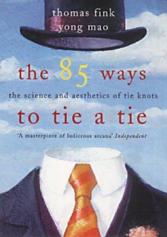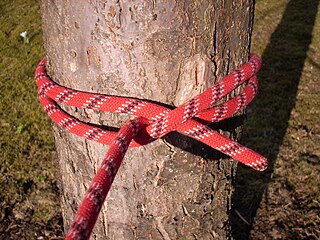
The clove hitch is a type of knot. Along with the bowline and the sheet bend, it is often considered one of the most important knots and is commonly referred to as a Double Hitch. A clove hitch is two successive half-hitches around an object. It is most effectively used as a crossing knot. It can be used as a binding knot, but is not particularly secure in that role. A clove hitch made around the rope's own standing part is known as either two half-hitches or buntline hitch, depending on whether the turns of the clove hitch progress away from or towards the hitched object.
Although the name clove hitch is given by Falconer in his Dictionary of 1769, the knot is much older, having been tied in ratlines at least as early as the first quarter of the sixteenth century. This is shown in early sculpture and paintings. A round turn is taken with the ratline and then a hitch is added below. The forward end is always the first to be made fast.
The difference between two half hitches and the clove hitch is that the former, after a single turn around a spar, is made fast around its own standing part, while the latter is tied directly around the spar.
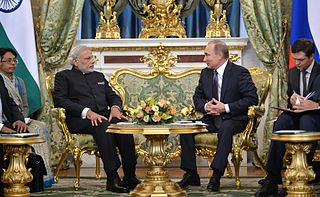
A suit is a set of men's wear comprising a lounge jacket and trousers. When of identical textile, and worn with a collared dress shirt, necktie, and dress shoes, it is traditionally considered informal wear in Western dress codes. The lounge suit originated as 19th-century casual sports and country wear in Britain, still reflected in the sport coat and blazer worn as smart casual. After replacing the black frock coat in the early 20th century, a darker suit also became known as a business suit for professional occasions, when sober in style.
In CPU design, the use of a sum-addressed decoder (SAD) or sum-addressed memory (SAM) decoder is a method of reducing the latency of the CPU cache access and address calculation. This is achieved by fusing the address generation sum operation with the decode operation in the cache SRAM.

The bow tie is a type of necktie. A modern bow tie is tied using a common shoelace knot, which is also called the bow knot for that reason. It consists of a ribbon of fabric tied around the collar of a shirt in a symmetrical manner so that the two opposite ends form loops.

The cravat is a neckband, the forerunner of the modern tailored necktie and bow tie, originating from a style worn by members of the seventeenth-century military unit known as the Croats.
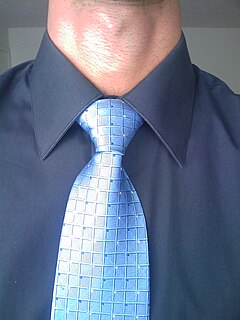
The Windsor knot, also referred to as a Full Windsor or as a Double Windsor to distinguish it from the half-Windsor, is a method of tying a necktie. The Windsor knot, compared to other methods, produces a wide symmetrical triangular knot.

A scarf, plural scarves, is a piece of fabric worn around the neck for warmth, sun protection, cleanliness, fashion, or religious reasons. They can be made in a variety of different materials such as wool, linen or cotton. It is a common type of neckwear.

The buntline hitch is a knot used for attaching a rope to an object. It is formed by passing the working end around an object, then making a clove hitch around the rope's standing part, taking care that the turns of the clove hitch progress towards the object rather than away from it. Secure and easily tied, the buntline hitch will jam when subjected to extreme loads. Given the knot's propensity to jam, it is often made in slipped form.
The buntline hitch, when bent to a yard, makes a more secure knot than two half hitches, but is more liable to jam. It differs from two half hitches in that the second half hitch is inside instead of outside the first one.

The four-in-hand knot is a method of tying a necktie. It is also known as a simple knot or schoolboy knot, due to its simplicity and style. Some reports state that carriage drivers tied their reins with a four-in-hand knot, while others claim that the carriage drivers wore their scarves in the manner of a four-in-hand, but the most likely etymology is that members of the Four-in-Hand Club in London began to wear the neckwear, making it fashionable. The knot produced by this method is on the narrow side, notably asymmetric, and appropriate for most, but not all occasions. For United States Army uniforms, and United States Navy uniforms that include a necktie, the four-in-hand knot is one of three prescribed options for tying the necktie, the other two being the half-Windsor and Windsor.

Sherman's neckties were a railway-destruction tactic used in the American Civil War. Named after Maj. Gen. William Tecumseh Sherman of the Union Army, Sherman's neckties were railway rails destroyed by heating them until they were malleable and twisting them into loops resembling neckties, often around trees. Since the Confederacy had limited supplies of iron, and few foundries to roll the rails, this destruction was very difficult to repair. They were also called Sherman's bow ties or Sherman's hairpins.

The half-Windsor knot, also known as the single Windsor knot, is a way of tying a necktie which produces a neat, triangular knot. It is larger than the four-in-hand knot and Pratt knot, but smaller than the Windsor knot. The half-Windsor is derived from the Windsor in that it is only brought up around the loop on one side rather than both. It works well with light- and medium-weight fabrics.
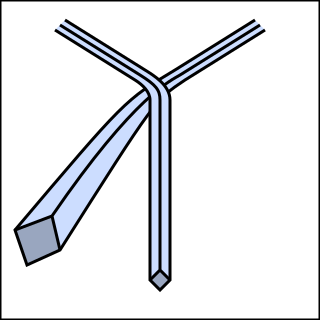
The Pratt knot is a method of tying a necktie. It is also known as the Shelby knot and the Pratt-Shelby. The knot was created by Jerry Pratt, an employee of the US Chamber of Commerce in the late 1950s. It was popularized as the Shelby knot after then 92-year-old Pratt taught it in 1986 to television reporter Don Shelby who he felt had been tying his tie poorly on the air. Shelby then refined the Pratt knot with local clothier Kingford Bavender and wore it on the air with a spread collar where it stood out and attracted attention for its symmetry and trim precision.

The small knot, or oriental knot or Kent knot or simple knot, is the simplest method of tying a necktie, though some claim the simple knot is an alternative name for the four-in-hand knot. The small knot is not very well known despite its simplicity. One of the reasons may be that the small knot is not self-releasing, and may annoy people accustomed to four-in-hand and Windsor knots who pull at the tie to untangle the knot. Additionally, some prefer that, if the thin end of the tie should become visible, that it not be "inside out", and the small knot will be this way.
Neckwear refers to various styles of clothing worn around the (human) neck. They are worn for fashion, combat, or protection against the influences of weather. Common neckwear today includes bow ties, neckties (cravat), scarves, feather boas and shawls. Historically, ruffs and bands were worn.
Knitted Tie, or Knit Tie is a neckwear can be worn a casual wear, or business casual, if worn with dress shirt or casual collar shirt. it can also be worn casual wear a casual collar shirt, Jeans and Sport coat are acceptable for men.

